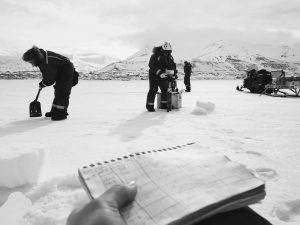Project description
 Sea ice was a once prevalent feature of the Arctic, but we are in a time of change. Svalbard is one of the most rapidly changing Arctic regions, with fjordic systems changing from an Arctic to an Atlantic state. Alongside this change, is the either lack or unpredictable formation of sea ice. Not only an important habitat for charismatic marine mammals, such as polar bears, sea ice is a whole ecosystem itself. Living within the tiny (<1mm) channels inside of sea ice, a diverse community consisting of viruses, bacteria, ice algae and metazoans can be found.
Sea ice was a once prevalent feature of the Arctic, but we are in a time of change. Svalbard is one of the most rapidly changing Arctic regions, with fjordic systems changing from an Arctic to an Atlantic state. Alongside this change, is the either lack or unpredictable formation of sea ice. Not only an important habitat for charismatic marine mammals, such as polar bears, sea ice is a whole ecosystem itself. Living within the tiny (<1mm) channels inside of sea ice, a diverse community consisting of viruses, bacteria, ice algae and metazoans can be found.
This project will focus on ice algae, which offer a nutritious food source in early spring after the dark winter. A rich source of polyunsaturated fatty acids, they kick-start the Arctic marine ecosystem by fueling reproduction and growth of zooplankton.
Tasks
The fieldwork would include a day trip of sea ice sampling with snowmobile (drivers license is preferred). Sampling will include the collection of sea ice cores, and water samples. The student will also be responsible for filtration of chlorophyll a and POC/PON samples, as well as measuring sea ice salinity. If time allows, chlorophyll a analysis can also be done.
Key words: Sea ice, ice algae, chlorophyll a, POC/PON, bulk salinity
NB! The field days are long (10+ hours) and students should be prepared to be outside in the cold the whole day. Participation in fieldwork is not mandatory, but is offered for a fuller experience.
The project involves:
This project involved an optional field day and filtrations.
Starting date/period:
March – May 2022 (can potentially be extended to June 2022 if chlorophyll a analysis remains to be done)
Experience/skills to be acquired:
After participation, students will be capable of sea ice-based fieldwork and learn filtration techniques. Potentially, chlorophyll a analysis will be learnt.
Involvement:
The student will be involved in the yearly monitoring of sea ice in Van Mijenfjorden. The student would learn about packing and conducting fieldwork, as well as lab techniques. The collected data will be part of two PhD theses and the student will be a great asset to the work by providing an extra helping hand.
Maximum 40 hours in total.
Interested in this project or need more info? Contact:
Vanessa Pitusi (vanessap@unis.no)
Project number: 19
